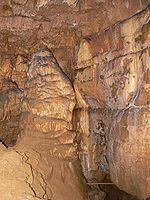Gold hole
| Gold hole
|
||
|---|---|---|
|
Entrance to the gold hole |
||
| Location: | Swabian Alb , Germany | |
| Height : | 788 m above sea level NN | |
|
Geographic location: |
48 ° 24 '51 " N , 9 ° 14' 14" E | |
|
|
||
| Type: | Stalactite cave | |
| Lighting: | No | |
| Overall length: | approx. 45 m | |
| Level difference: | approx. 10 m | |
The gold hole ( or money hole ) in the Gaisspitzberg near Lichtenstein in Baden-Württemberg is an undeveloped natural cave in the Swabian Alb .
geology
The Goldloch is a cave in the Swabian Alb , which was originally created by faulting gaps in the banked limestone of the Lower Rock Limestone Formation , directly on the Alb eaves . Their length is given as 45 meters, the greatest clear height as 6 meters. The cave entrance is about 788 m above sea level. NN . Gold is not found in the rock in and around the gold hole, even if the name seems to indicate it (see history and legend).
The gold hole houses some stalactites . It ends in a lower round chamber with a small hollowed-out ceiling dome, the diameter of which is about 30 cm. The floor is made of slab material and clay .
The State Office for Geology, Raw Materials and Mining in Freiburg (LGRB) classifies the gold hole as a geotope worthy of protection.
The Goldloch is located near Lichtenstein Castle near the path to the Nebelhöhle , the second most popular show cave in the Swabian Alb after the Karls- und Bärenhöhle .
Directions
From Stuttgart towards Pfullingen , then Lichtenstein, Unterhausen district. In Unterhausen, a small winding road leads up the mountain towards the Nebelhöhle. After about 5 kilometers you will reach the Kalkofenhütte. About 50 meters from the Kalkofenhütte a path leads to the casting stone. From the road, the path turns left after about 200 meters. A steep, unpaved trail leads 30-40 meters down the slope directly in front of the entrance to the gold hole, which cannot be discovered from the path and is not signposted. The gold hole should not be used from October to March because of the bats that live there .
History and legend
The name of the cave has two presumed origins. Either it goes back to an unspecified larger gold coin find in 1778, or to the golden yellow color of the Maria (or Madonna) with child in the back of the cave. The gold-colored coating, which comes from iron ocher, must have glowed even more intensely in ancient times in the light of torchlight . According to legend, kissing the foot of the Madonna is said to be beneficial to one's own wealth.
See also
Individual evidence
literature
- Hans Joachim Haupt: Discover with children - wild caves in the Swabian Alb. Fleischhauer & Spohn, Bietigheim-Bissingen 2002, p. 35, ISBN 3-87230-576-X .
- Hans Binder , Herbert Jantschke: Cave guide Swabian Alb. Caves - springs - waterfalls . 7th completely revised edition. DRW-Verlag, Leinfelden-Echterdingen 2003, ISBN 3-87181-485-7 , p. 86 .




